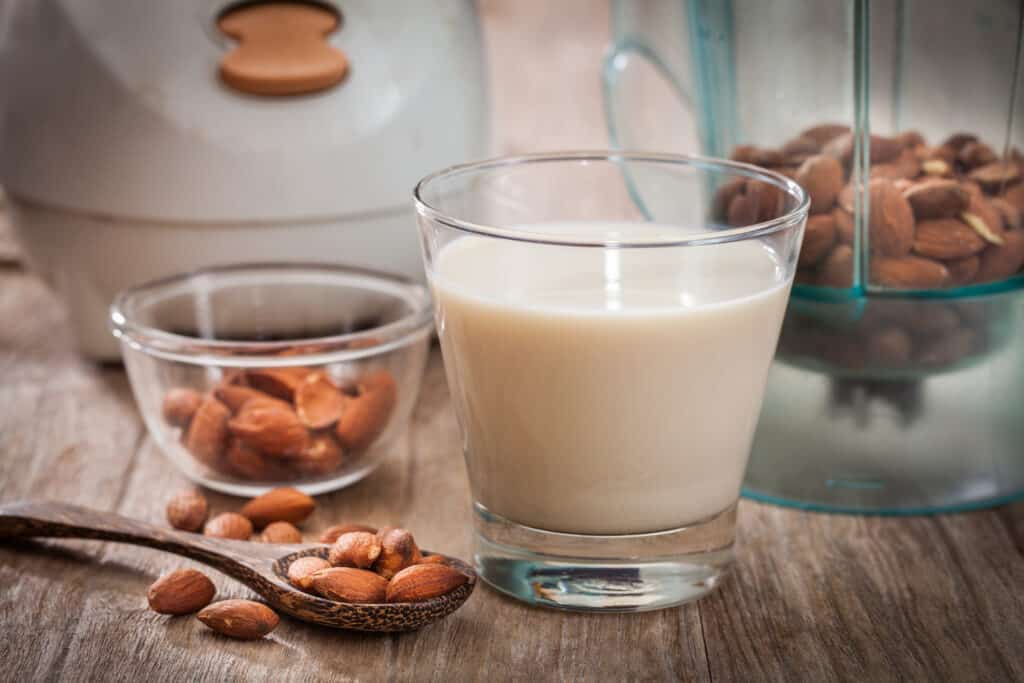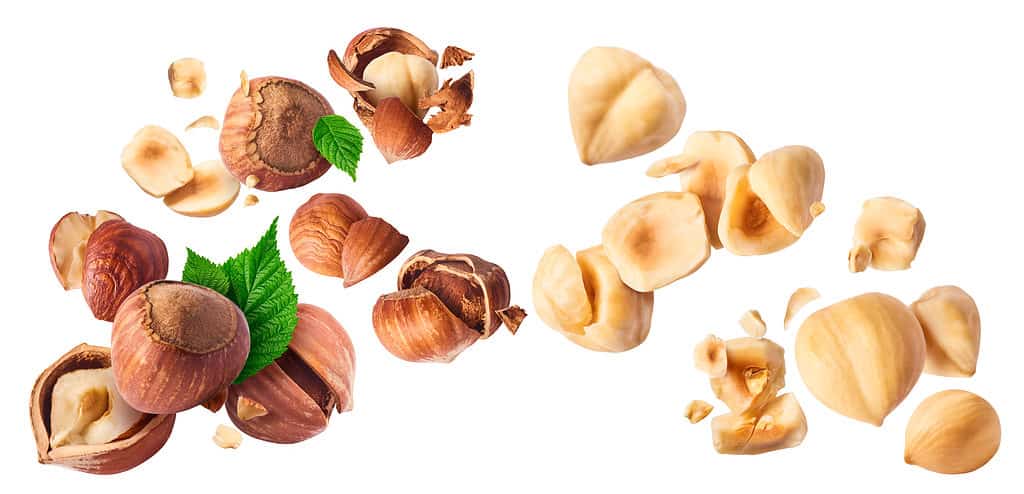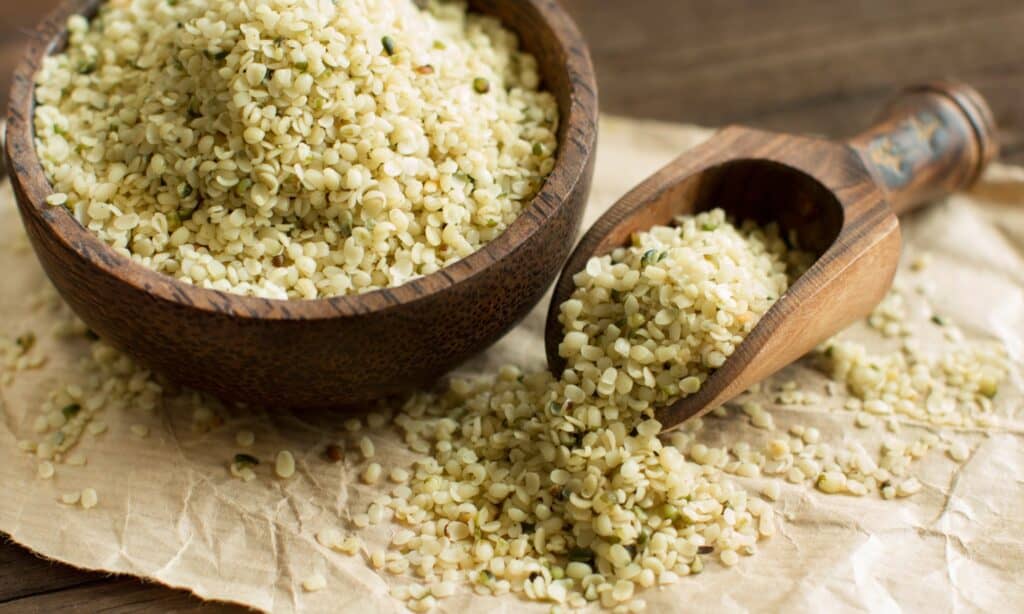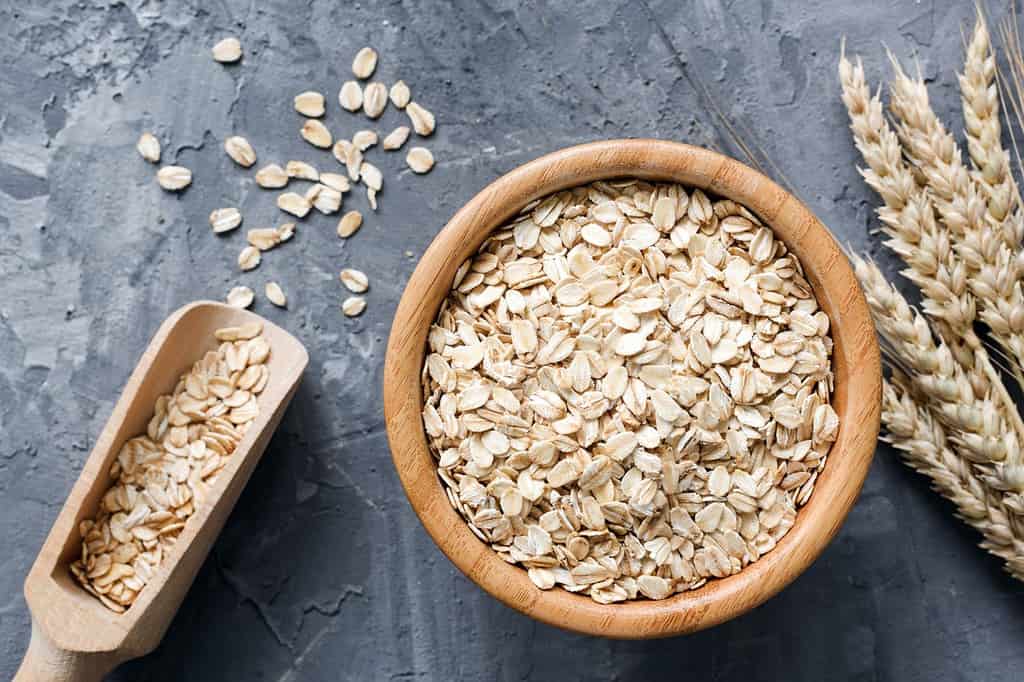There are dozens of types of milk out there to choose from. There are the standard kinds of milk from cows and soy, which have been around for a while. However, there are many more alternatives than that. To learn about some of the most common milk types, their taste, and how to pick one to best fit your needs, keep scrolling.
Animal-Based Milks
Animal-based milks were some of the first milks out there. There are several different types of milk just from cows alone to know about.
1. Whole Milk

Whole milk was the standard milk for a long time, thanks to its nutrients and creamy flavor.
©Sam Edwards/OJO Images via Getty Images
When it comes to milk, whole milk is the standard. Besides a little homogenization and pasteurization, it’s the milk that comes straight out of the cow. There is no fat taken out, so there’s roughly 3.25 percent milkfat by weight. You have the option to get milk as organic or non-organic, depending on your preferences and the cost.
Taste Profile
Whole milk is described as thick and creamy because of the higher levels of fat in it. It’s also usually got a hint of natural sweetness.
Nutrition
Whole milk has 150 calories in an eight-ounce serving. There’s also 8 grams of fat, 7.5 grams of protein, and 12 grams of natural sugar. Milk from cows provides important nutrients, especially calcium. Many are now fortified with vitamin D as well because it is absorbed closely with calcium.
2. 2 Percent Milk

Though skim milk has similar levels of nutrients, your body needs fat to properly absorb it.
©George Marks/Retrofile RF via Getty Images
Two percent milk and other milk flavors came about as a popular drink when doctors started recommending it to people as a healthier option to whole milk. It’s milk with some of the fat taken out, so it was promoted as a low-fat and healthier alternative to whole milk. While there’s only a 1.25 percent difference by weight in fat between the two milks, there was a lot of two percent milk left over after WWII in powdered form, and the government had to figure out how to sell it somehow.
Taste Profile
Two percent milk is a step down from whole milk, but still a better option than low-fat and fat-free milk for those who like a full and creamy taste. It’s still fairly creamy, but not as rich or thick as whole milk. Sometimes, to help people like the taste more, additional sugars are added.
Nutrition
Two percent milk doesn’t have quite as many calories as whole milk. It’s usually around 140 calories for eight ounces of milk. Since some of the fat is removed, it’s also lower in fat at about 5 grams. The protein is higher as well, sometimes between 9 and 10 grams. The sugars are the same at 12 calories per serving. It’s still a good source of calcium, vitamin D, and vitamin A.
3. Lactose-Free Milk

Lactose-free milk is very similar to regular whole cow’s milk.
©Chatham172/Shutterstock.com
A good chunk of the population has problems with lactose. This is because people aren’t really made to continue drinking milk after weaning. While some people handle it fine into adulthood, others grow lactose intolerant. This intolerance is due to a lack of a milk-digesting enzyme in the body called lactase. This milk comes with lactase in it, so that it can go ahead and digest the milk the way your body can’t.
Taste Profile
Lactose-free milk has the same thickness and mouth feel to it that regular milk does. The main difference between milk and lactose-free milk is that milk missing lactose tends to be sweeter. This is because lactase, which is the enzyme added to milk to make it free of lactose, breaks down the lactose into glucose and galactose, which taste sweet.
Nutrition
As far as nutrition, lactose-free milk isn’t all that different from regular milk. It has 146 calories, 7.8 grams of fat, 8 grams of protein, and 12 grams of sugar. The vitamin and mineral content is about the same as well, with most of the nutrients centering around calcium.
Nut-Based Milks
Nut-based milks have a lot of benefits. They are full of nutrients, easy to make at home, and are generally better for the environment than dairy types of milk. Unfortunately, they aren’t perfect for everyone because many people are allergic to nuts of some form.
4. Almond Milk

If you’re looking for milk you can make at home, almond milk is a great option.
©iStock.com/naito8
When it comes to non-dairy milk alternatives, almond and soy are usually the two most common second alternatives. Almond milk wins out because it usually has fewer calories than soy milk, and it is easy to make at home.
Taste Profile
Almond milk is probably one of the closest taste profiles to dairy milk types of milk. It’s sweet and creamy. Sometimes, it may be a little grainy. It’s easy to make thicker, so it’s more similar in texture to milk than water.
Nutrition
Nutrition varies greatly from brand to brand, but if you make it yourself, it’s about 60 calories per eight-ounce serving. Additionally, there are about 5 grams of fat, 1 gram of protein, and no sugar. Like dairy milk, almonds also offer a good amount of calcium, and they also have the added benefit of providing vitamin A.
5. Cashew Milk

Cashews, like many other nuts, are rather easy to turn into milk.
©iStock.com/etiennevoss
Even without any sugar or sugar alternatives, cashew milk is incredibly sweet. It’s an excellent addition to any dessert. Despite the sweetness, it’s full of nutrients that are necessary to keep the body healthy. However, it is lacking in protein compared to other milks.
Taste Profile
The flavor profile of cashew milk is rather sweet and creamy. It’s a mild flavor that doesn’t overpower most other tastes. It’s closest in taste to almond milk but with a much sweeter and more mild flavor profile.
Nutrition
Cashew milk is a healthy milk to add to your diet. One eight-ounce service has only around 25 calories, 2 grams of fat, and 1 gram of protein. It’s also a good source of vitamins E and A, and iron. Store-bought cashew milks also tend to have vitamin D and calcium added in to replace the nutrients you’re missing out on by not drinking dairy milk.
7. Hazelnut Milk

Hazelnuts are full of nutrients and can be eaten in a wide variety of ways.
©Agave Studio/Shutterstock.com
For anyone who is a fan of Nutella, hazelnut milk is a must-try. It doesn’t work for every dish and drink, but it can make your morning coffee and oatmeal pop. It’s not a foamy milk, but it mixes well with other milks like oat milk to create a better foam if that’s what you like in your morning latte.
Taste Profile
Hazelnut milk has a pretty bold taste. It will remind you of hazelnuts with every sip. It’s often compared to the taste of dairy milk left in the bowl after eating shredded wheat cereal. Since it has a fair amount of fat in it, the drink is also pretty creamy and thick.
Because of the bold flavor, this milk doesn’t work for everything. However, it’s a great milk to try.
Nutrition
Unsweetened hazelnut milk has somewhere around 30 calories in it per cup There is 1 gram of protein, 3 grams of fat, and no sugar. Like with most other milk, there’s a fair amount of calcium. Though not a lot, you get a bit of iron and potassium from hazelnut milk as well.
Plant-Based Milks
Plant-based milks are the final option. These are milks made from a variety of different plants that aren’t nuts. There’s also a wide range of flavor differences between the different types of plant-based milks.
7. Coconut Milk

Coconut milk is processed using the meat inside of coconuts.
©nadisja/Shutterstock.com
Like nut-based milks, coconut milk comes from blending coconuts. Usually, the meat of the coconut, or the thick white area that is often eaten, is blended with the water inside. There’s thick coconut milk, which is boiled down and much higher in calories. It has a similar texture to cream. Then there’s thin coconut milk that is strained and is closer to water in texture.
Taste Profile
Coconut milk tends to have a nutty flavor. It’s rather sweet tasting, which makes it a popular milk to put into various desserts. Some of the brands out there have a distinct coconut flavor, which isn’t pleasant for everyone.
Nutrition
Depending on the brand, there are somewhere around 40 to 50 calories per eight-ounce serving of standard thin coconut milk. Each cup of milk has 4 grams of fat, and no sugar or protein. Coconut milk is a good source of calcium, potassium, and vitamins D, A, E, and B12. This is the coconut milk you’ll find in cartons. Coconut milk in cans tends to be much higher in calories and isn’t necessarily meant to be used as a frequent milk replacement.
8. Hemp Milk

The hemp plant is often seen in a bad light but it has some pretty important uses.
©iStock.com/Karisssa
Despite being rather easy to make and having a creamy and delicious flavor profile, hemp sometimes flies under the radar for those looking for a milk alternative. Some of it may be that people are worried that hemp milk has some THC in it, but that’s not the case. It’s completely legal and contains nothing that would get you in trouble with your boss or the government.
Taste Profile
Hemp milk has a texture that’s not as thick as whole milk but is thicker than two percent milk. It’s creamy and may taste faintly like sunflower seeds or nutty. There’s also a slightly sweet aftertaste.
Nutrition
Hemp milk has about 130 calories in an eight-ounce serving. That cup of milk also contains 4 grams of protein, three grams of fat, and 15 grams of natural sugar. Though it’s a little higher in calories, it also contains a lot more important nutrients, such as unsaturated milk, all the essential amino acids, calcium, iron, phosphorus, zinc, and vitamins B12, D, and A.
9. Oat Milk

Oat milk is one of the best options out there for alternative milk.
©Vladislav Noseek/Shutterstock.com
There are so many benefits to using oat milk. For one, it’s a great swap from dairy milk as far as environmental factors. It’s also incredibly cheap. In stores, it’s a little pricey because it’s high in demand, but if you’re willing to make your own, it’s cheaper than standard or soy milk.
Taste Profile
The biggest downside when it comes to oat milk is the fact that it’s a little more watery. Many store-bought oat milks add xantham gum to the milk because it’s not only a thickener, but it helps to stabilize the milk. If you’re making the drink yourself, you may have to play around with portions until you get a thickness you want.
However, despite it being a little watery, it has a great flavor. It’s nutty and sweet, with a bit of creaminess to tie it all together. The flavor itself is also milder. This is great for those who don’t like the aftertaste of almond and soy milk in their drinks or cereal.
Nutrition
A cup of oat milk has around 80 calories if made at home. In stores, it’s closer to 120 calories. There are about 2.5 grams of protein, 4 grams of fat, and 7 grams of natural sugar. As far as important vitamins and minerals, oat milk has a good amount of calcium and B vitamins.
How to Pick the Right Milk for You
Everyone has their own preference for types of milk or milk alternatives. Depending on your needs, one may benefit you more than another.
Taste
If you’re looking to get away from cow’s milk for whatever reason, it can be hard to find another milk that has the right texture and taste. So far, milk like oat, soy, and almond tend to be the closest.
If you make your own, you may have to mess around with ratios until you get something close to what you want. If you’re buying it from a store, you may need to try a few different brands until you find one that you like, as every brand has a slightly different texture and flavor.
Nutrition
Some people are looking for low-calorie alternatives to whole milk, or milk with nutrients that fit what they need. Milk with reduced fat like low-fat or skim milk are great alternatives that still taste like regular milk. For milk alternatives, almond milk is considered one of the best for those looking to eat fewer carbs and calories while still getting plenty of nutrients.
Environmental Impacts
Some people make choices about the foods and drinks they consume and purchase based on their impacts on the environment. If that’s the case, then the best options are plant-based milks like hemp, soy, pea, and oat milk.
Dairy, almond, and rice milk are the worst for the environment. So at the very least, if you’re looking to make a good impact on the environment, these should be the three to avoid.
Cost
Not everyone has the option to pick milk that meets specific criteria. Sometimes, they can only pick what they can afford.
If you have extra time and don’t mind making your milk, that’s usually the cheapest option. Oat milk, for example, is incredibly cheap. You only need half a cup of rolled oats to make roughly four cups of oat milk.
So a whole cup of oats will provide you with the same amount of milk you buy in those cartons at a store. That means, for about seven dollars, you can get over three gallons of milk. Of course, the prices vary a bit based on what kind of rolled oat you buy and your area, but still, that’s a lot better than the price of milk already made in a store.
If you want milk that will last a bit longer on the shelf and doesn’t involve you making a lot of dishes, soy milk tends to be the cheapest across the board.
Summary of the 9 Types of Milk
| List Number | Type of Milk | Taste | Can You Make |
|---|---|---|---|
| 1 | Whole milk | Thick, creamy, and sweet | Not unless you own a cow |
| 2 | 2 percent milk | Sweet, but slightly watery | Not unless you own a cow |
| 3 | Skim milk | Similar to whole milk, but sweeter | You can add lactase to your milk, or take a pill containing the enzyme before drinking milk. |
| 4 | Almond milk | Sweet and nutty, not as thick | Yes with almonds and water |
| 5 | Cashew milk | Very sweet, thick, creamy, and milder flavor | Yes with cashews and water |
| 6 | Hazelnut milk | A strong hazelnut flavor, not as thick, but sweet | Yes with hazelnuts and water |
| 7 | Coconut milk | Sweet, creamy, with a bit of a coconut flavor | Yes, with unsweetened coconut and water |
| 8 | Hemp milk | A mild flavor, not as thick as whole milk | Yes with hemp seeds and water |
| 9 | Oat milk | Slightly watery if made at home with a mild flavor | Yes with oats and water |
Thank you for reading! Have some feedback for us? Contact the AZ Animals editorial team.








